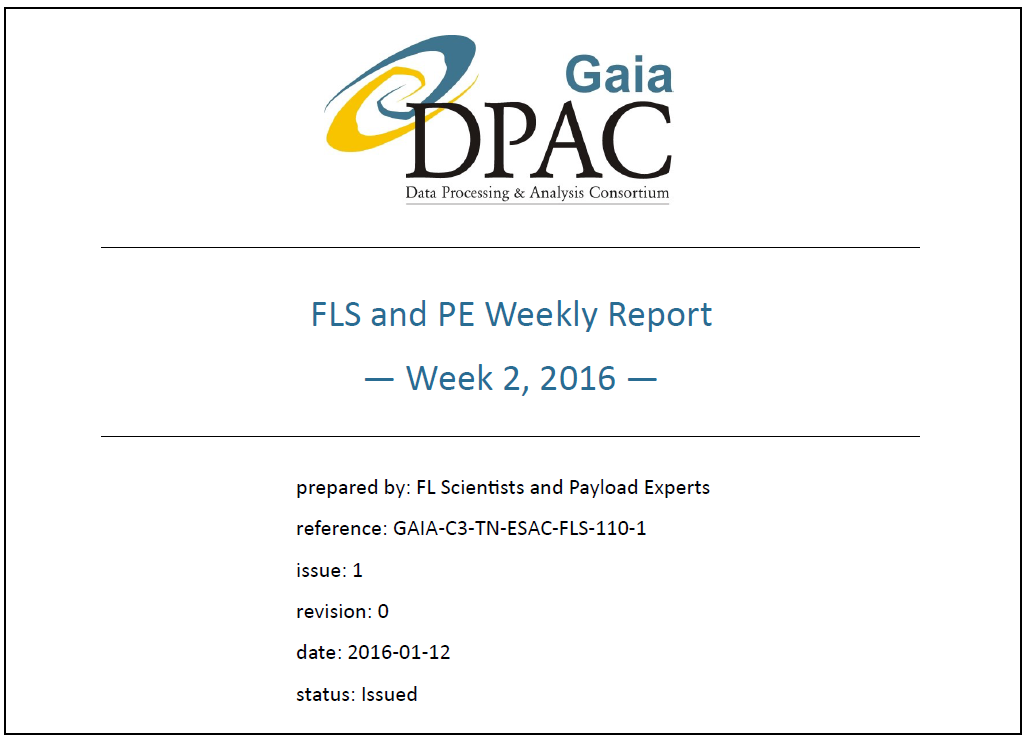|
Since early January 2014, the Gaia First-Look Scientists (FLS) team and the Payload Experts (PE) group, in co-operation with the Gaia Mission Operations Centre at ESOC, Darmstadt, have been checking Gaia's instrument health and its scientific data quality on a daily basis. All findings of problems and oddities as well as their resolution are continuously reported in FLS & PE Weekly Reports, internal documents for the people working on Gaia. Today the 100th report has been released (Figure 1), exactly two years after the first one appeared after the switch-on of Gaia's science instruments.
Tasked with detecting issues and sub-optimal conditions of diverse sorts and importance, the FLS team and PE group prompt actions to improve the performance of Gaia and of the data processing on ground whenever necessary. While Gaia is working very well and produces vast amounts of astrometric data in unprecedented quality and quantity, the task of the FLS team and PE group is to find and act on any and all troubles, however small they may be. This trouble-chasing will continue as deeper understanding of Gaia allows finding smaller and smaller effects. Yet for the final catalogue accuracies even the tiniest issues have to be understood. In the past two years of Gaia operations, including commissioning and nominal operations, 104 different problems and oddities were spotted in the data, out of which 89 have been resolved already. About half of the issues were linked to the spacecraft and the other half to the ground-processing software. Figure 2 gives one spacecraft-related example of an on-board optimisation achieved in this process, and also illustrates how the process of First-Look works.
One among the thousands of diagnostic quantities checked every day is a measure of the sharpness of the star images produced by Gaia's two telescopes (in fact this one consists of several such measures, for different parts of the Gaia focal plane). In early July 2015 the First-Look team identified the potential to improve the image sharpness in the astrometric section for one of Gaia's fields of view. The Payload Experts group discussed the matter in its weekly teleconference to be sure that a corrective action for the astrometric field would not reduce the image quality in the photometric and spectroscopic parts of the fields of view. In this case the group gave the green light for a refocussing recommendation from the science point of view. Subsequently, following Mission Manager approval, members of the Gaia Science Operations Centre at ESAC, Villafranca, worked out the details of the needed mirror movement in Telescope 1, and the Mission Operations Center at Darmstadt conducted the actual re-focussing in early August 2015 after having checked it for correctness, for possible risks, and for possible interference with other planned spacecraft operations. As can be seen in Figure 2, the refocussing activity improved the image sharpness, in other words the angular resolution of the telescope, by roughly 8%.
|
|
|
Figure 2: Time series of the image width measurements, derived by the First Look data processing chain nominally once a day. The data points show the so-called Cramer-Rao criterion for Gaia's Telescope 1 as a function of the DPAC-internal time scale OBMT (one rev equals six hours). The smaller the value, the better the image sharpness. The planned re-focussing took place on 3 August 2015 (OBMT rev. 2574.7). For completely unrelated technical reasons, the First Look's image sharpness diagnostic could not be run for about 10 days shortly after the refocussing, producing a data gap in this plot.
|
|








































 Sign in
Sign in
 Science & Technology
Science & Technology


